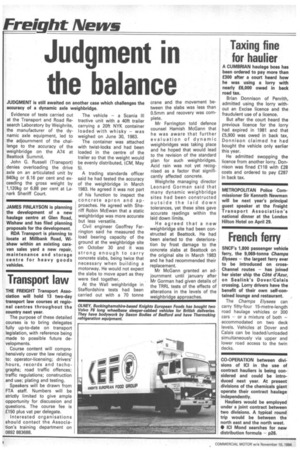Judgment in the balance
Page 16

If you've noticed an error in this article please click here to report it so we can fix it.
JUDGMENT is still awaited on another case which challenges the accuracy of a dynamic axle weighbridge.
Evidence of tests carried out at the Transport and Road Research Laboratory by Weighrite, the manufacturer of the dynamic axle equipment, led to the adjournment of the challenge to the accuracy of the weighbridge on the A74 at Beattock Summit.
John G. Russell (Transport) denies overloading the drive axle on an articulated unit by 840kg or 8.16 per cent and exceeding the gross weight by 1,120kg or 6.88 per cent at Lanark Sheriff Court. The vehicle — a Scania ill tractive unit with a 40ft trailer carrying a 20ft NYK container loaded with whisky — was weighed on June 30, 1983.
The container was attached with twist-locks and had been loaded in the centre of the trailer so that the weight would be evenly distributed, (CM, May 5).
A trading standards officer said he had tested the accuracy of the weighbridge in March 1983. He agreed it was not part of his function to inspect the concrete apron and approaches. He agreed with Sheriff Robin McEwan that a static weighbridge was more accurate but less versatile.
Civil engineer Geoffrey Farrington said he measured the load bearing capacity of the ground at the weighbridge site on October 30 and it was strong enough to carry concrete slabs, being twice that necessary when building a motorway. He would not expect the slabs to move apart as they were tied together.
At the Wall weighbridge in Staffordshire tests had been carried out with a 70 tonne crane and the movement between the slabs was less than 0.5mm and recovery was complete.
Mr Farrington told defence counsel Hamish McGann that he was aware that further evaluation of dynamic weighbridges was taking place and he hoped that would lead to the revision of the standard plan for such weighbridges. Acid rain was not yet recognised as a factor that significantly affected concrete.
Weighrite managing director Leonard Gorman said that many dynamic weighbridge sites had been constructed outside the laid down tolerances, yet these sites gave accurate readings within the laid down limits.
He agreed that a new weighbridge site had been constructed at Beattock. He had been alerted to the deterioration by frost damage to the concrete slabs at Beattock on the original site in March 1983 and he had recommended their replacement.
Mr McGann granted an adjournment until january after Mr Gorman had given details of the TRRL tests of the effects of alterations in the levels of the weighbridge approaches.




































































































